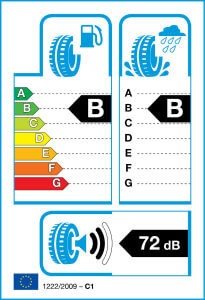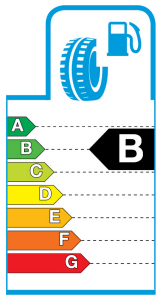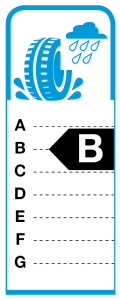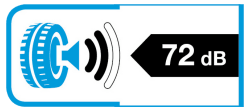

To help tyre safety, reduce the impact on the environment and educate car drivers around Europe the EU introduced a universal tyre labelling system. The EU legislation was first introduced on 1st November 2012, this introduced a universal rating and label for each tyre allowing a quick and easy method of judging a tyres effectiveness.
From November 2012 it is a requirement for all new tyres to have undertaken the various tests and to be applied the appropriate rating. The ratings are for fuel efficiency, wet grip performance &rolling noise, the ratings apply to car, van, 4x4 and most truck tyres.
The labels are often described as being similar in appearance to energy labels seen on household white goods and provide a quick visual reference on the tyres rating. Fuel Efficiency and Wet Grip are rated on a simple sliding scale between A and G whilst the rolling noise is stated in db sound levels and a 3 bar visual.
There are some tyres which are exempt from this rating system such as tyres designed for racing, off-road use, temporary use, retreads and some vintage/heritage tyres.
You can view the official EU guide to tyre labelling here

The tyres on your vehicle play a considerable role in the fuel efficiency to the effect of 20% to 30%. As your tyres move across the road surface they use energy due to the resistance between the rubber and the surface. A tyre with a lower rolling resistance will therefor use less energy, produce better fuel efficiency and less CO2.
To give an idea of how the ratings impact fuel effeciency, a tyre rated at A (good) will use around 7.5% less fuel as a tyre rated at G (bad). For the typical average family car travelling 12,000 miles a year, this can equate to around 120 litres of fuel per year, or around £150 of fuel saving (£1.2pl).
At the time of writing this article, tyre ratings for fuel efficiency don't use the rating of D to provide a 'break point' between good and bad tyres.

When looking at the ratings, wet grip performance is the most important in regards to the safety of your tyres. The rating system follows the same A (good) to G (bad) sliding scale as fuel efficiency, so an A rated tyre will stop at a shorter distance to a G rated tyre.
Two different tests are used to determine wet grip performance, these are done by driving a vehicle to 50mph and then braking on a wet road. The two test results are combined together to form the rating of the tyre, again like fuel efficiency the D rating isn't used.
When comparing the results, there is approximately 3 meters difference in braking distance between each letter rating. This means a tyre rated A will stop a massive 18 meters before a tyre rated at G. When it comes to road safety, 18 meters can be the difference between no collision or a fatal collision.

To educate and encourage drivers to think of noise pollution, the rolling noise of the tyre was included on the EU labels. The thinking behind this is that by including it on the labels it will encourage people to think about noise pollution which is often overlooked .
In order to test the rolling noise, a microphone setup is used to measure the noise emitted from the tyres whilst rolling at 50mph speed. The vehicle is taken up to 50mph, the engine is cut and then the sound emitted is recorded accurately in decibels.
As well as the decibel rating (db), the tyre labels also use a sound wave visual, this consists of 3 bars which are coloured black to indicate a level of 1, 2 or 3. As it stands, all 3 bars is the old legal limit and new tyres should be under this, 2 bars is the new sound limit which was applied in 2016/17 and a single bar is 3db below the legal limit.
Whilst a few db doesn't seem like much difference, it is worth remembering that db are not on a linear scale and thus 3db difference is effectively half the noise pollution.